We can find around thirty Clerodendrum in Laos, we have already mentioned four and the fifth is Clerodendrum indicum. Like the others, it is a fairly decorative plant but undoubtedly less fragile; Originally from Malaysia, it adapts very well in all tropics to the point of becoming invasive as in Florida. In Laos it lives near homes, in wastelands, but is also cultivated in gardens.
It is a semi-woody plant 1 to 2 m high with leaves inserted at several points all around the quadrangular stem (we would say that they are whorled); they are lanceolate to linear, dark green. As in all species of this genus, it is mainly the flowers that attract attention; at the end of each stem large inflorescences are formed composed of numerous white flowers; each is a long narrow curved tube with five lobes from which the dark red stamens and style escape. Also dark red is the calyx with 5 sepals which will bear the fruit when the petals have fallen; the fruit itself is often a beautiful metallic blue, when it falls in turn, the calyx remains which forms like a new flower.
We have already given the origin of the scientific name of the genus taken elsewhere in French; one of the English names recalls the long tube of the flower, the other the turban of a Turk?? Lao names, like Thai names, are very varied, not very precise because they apply to several species of this genus whose similarities are well perceived.
Dok lèng song, also called dok phoum phing, is used in traditional medicine. The root is grated in water which is drunk throughout the day in case of asthma or congestion of the bronchi. The leaves are said to be a good dewormer and are also prepared as a bitter tonic. These same uses are found in Ayurvedic medicine in India, with additional use as an anti-inflammatory. It should be noted that it was possible to isolate in the laboratory a component of this Clerodendrum effective in dilating the bronchi. Finally, one of our informants in Laos states that the leaves can be smoked as a narcotic.
On peut trouver au Laos une trentaine de Clérodendrons, nous en avons déjà évoqués quatre et le cinquième est Clerodendrum indicum. Comme les autres il s’agit d’une plante assez décorative mais sans doute moins fragiles; originaire de Malaisie, elle s’adapte très bien sous tous les tropiques au point de devenir invasive comme en Floride. Au Laos elle vit à proximité des habitations, dans les friches, mais est aussi cultivée dans les jardins
C’est une plante semi-ligneuse haute de 1 à 2 m aux feuilles insérées en plusieurs points tout autour de la tige quadrangulaire (on dira qu’elles sont verticillées); elles sont lancéolées à linéaires, vert foncé. Comme dans toutes les espèces de ce genre, ce sont surtout les fleurs qui retiennent l’attention; au bout de chaque tige de grandes inflorescences se forment composées de nombreuses fleurs blanches; chacune est un long tube étroit recourbé à cinq lobes d’où s’échappent les étamines et le style, rouges foncés. Est également rouge foncé le calice à 5 sépales qui portera le fruit quand les pétales seront tombés; le fruit lui-même est souvent d’un beau bleu métallique, lorsqu’il tombe à son tour, subsiste le calice qui forme comme une nouvelle fleur.
Nous avons déjà donné l’origine du nom scientifique du genre repris par ailleurs en français; l’un des noms anglais rappelle le long tube de la fleur, l’autre le turban d’un Turc ?? Les noms lao, comme les noms thaï, sont très variés, peu précis car ils s’appliquent à plusieurs espèces de ce genre dont les ressemblances sont bien perçues.
Dok lèng song, appelée aussi dok phoum phing, est employé en médecine traditionnelle. La racine est râpée dans de l’eau qui est bue tout au long de la journée en cas d’asthme ou d’encombrement des bronches. Les feuilles seraient un bon vermifuge et elles sont également préparées comme tonic amer. On retrouve ces mêmes usages dans la médecine ayurvédique en Inde, avec en outre un emploi comme anti-inflammatoire. Il faut noter que l’on a pu isoler en laboratoire un composant de ce Clerodendron efficace pour dilater les bronches. Enfin l’un de nos informateurs au Laos affirme que les feuilles peuvent être fumées comme stupéfiant.
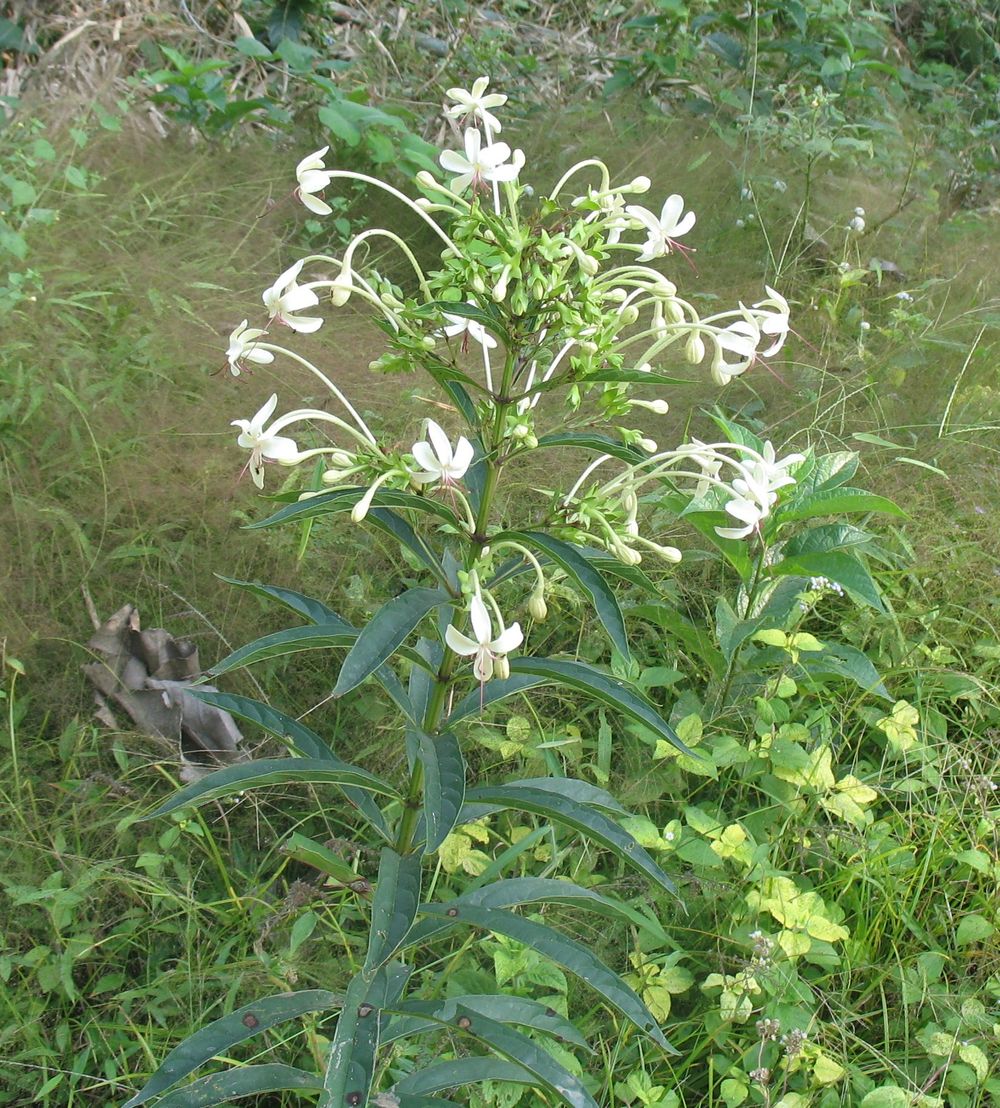
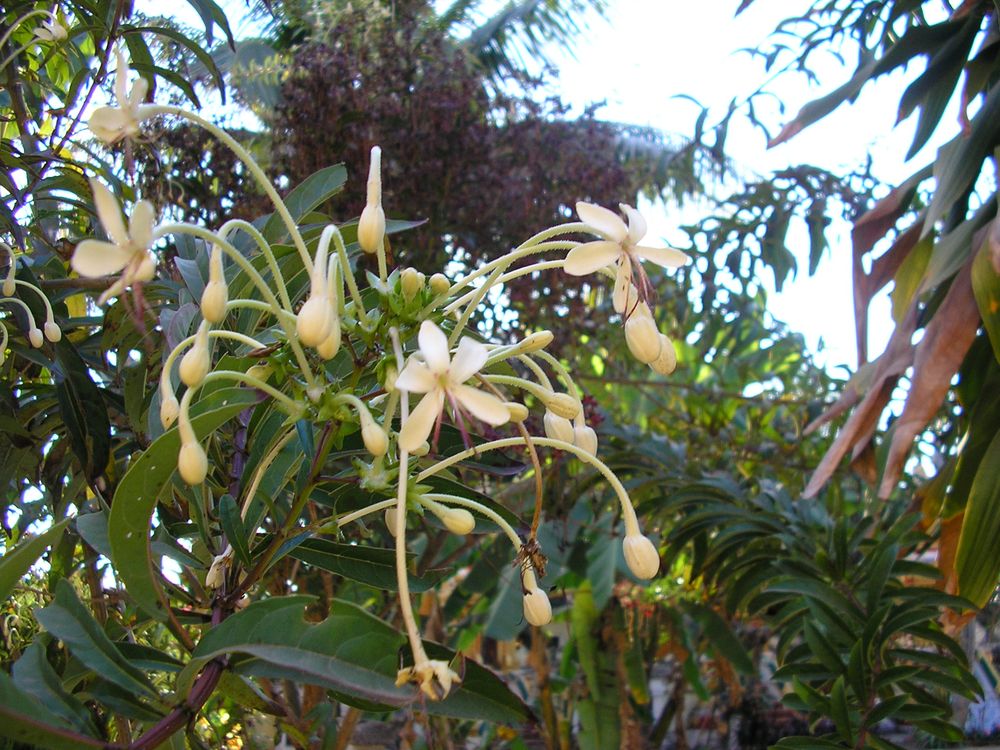
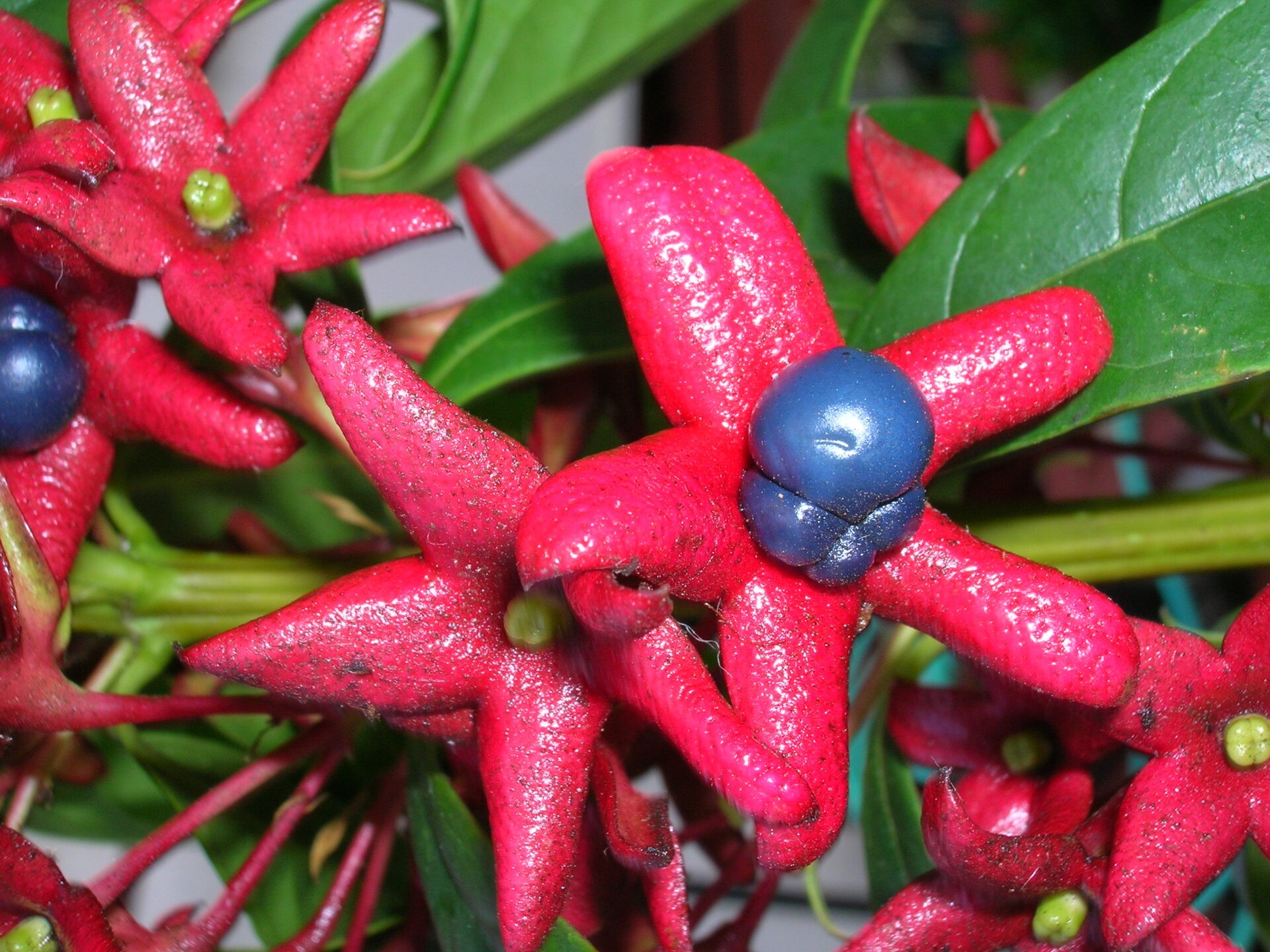
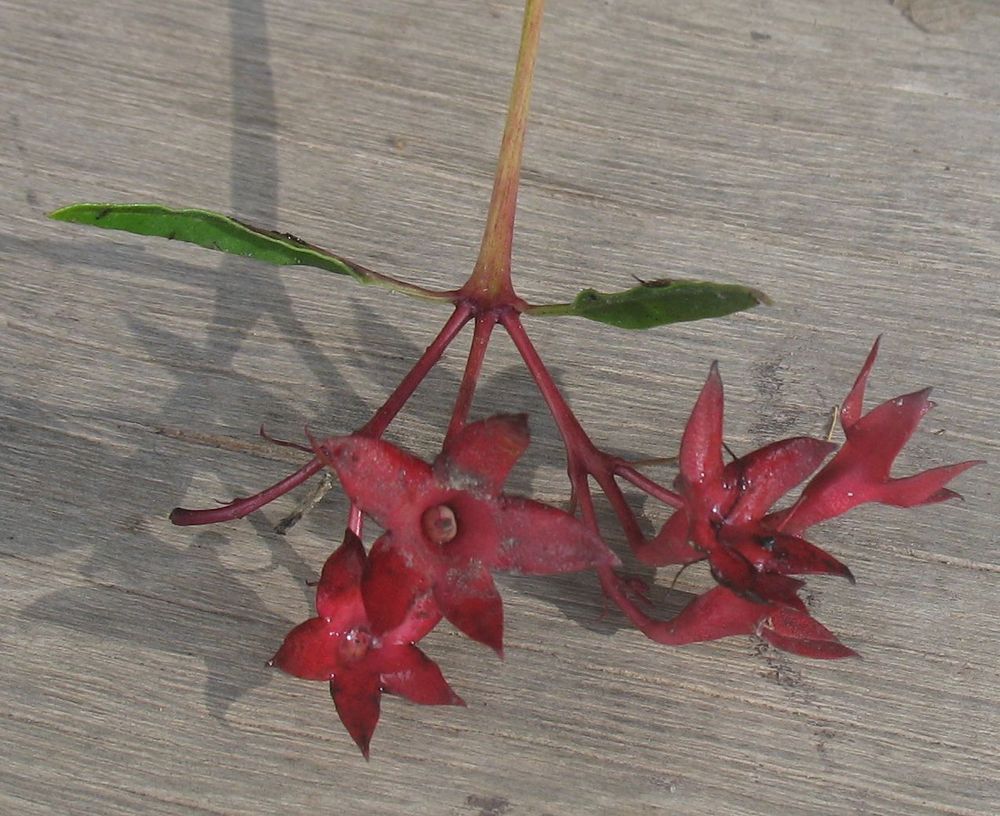
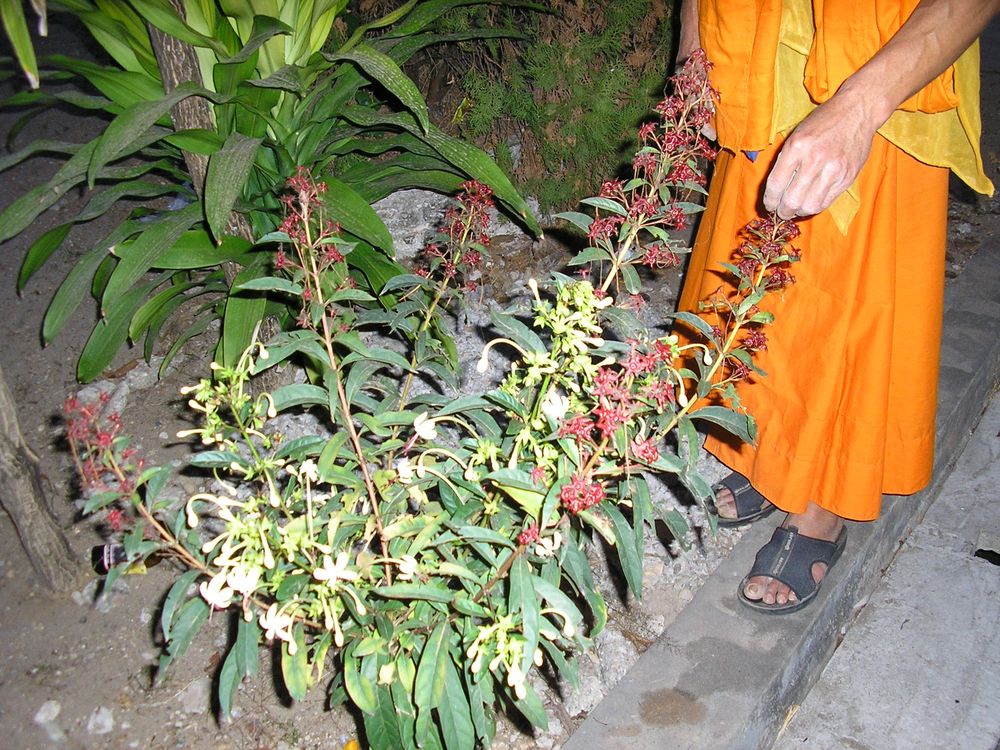
We can find around thirty Clerodendrum in Laos, we have already mentioned four and the fifth is Clerodendrum indicum. Like the others, it is a fairly decorative plant but undoubtedly less fragile; Originally from Malaysia, it adapts very well in all tropics to the point of becoming invasive as in Florida. In Laos it lives near homes, in wastelands, but is also cultivated in gardens.
It is a semi-woody plant 1 to 2 m high with leaves inserted at several points all around the quadrangular stem (we would say that they are whorled); they are lanceolate to linear, dark green. As in all species of this genus, it is mainly the flowers that attract attention; at the end of each stem large inflorescences are formed composed of numerous white flowers; each is a long narrow curved tube with five lobes from which the dark red stamens and style escape. Also dark red is the calyx with 5 sepals which will bear the fruit when the petals have fallen; the fruit itself is often a beautiful metallic blue, when it falls in turn, the calyx remains which forms like a new flower.
We have already given the origin of the scientific name of the genus taken elsewhere in French; one of the English names recalls the long tube of the flower, the other the turban of a Turk?? Lao names, like Thai names, are very varied, not very precise because they apply to several species of this genus whose similarities are well perceived.
Dok lèng song, also called dok phoum phing, is used in traditional medicine. The root is grated in water which is drunk throughout the day in case of asthma or congestion of the bronchi. The leaves are said to be a good dewormer and are also prepared as a bitter tonic. These same uses are found in Ayurvedic medicine in India, with additional use as an anti-inflammatory. It should be noted that it was possible to isolate in the laboratory a component of this Clerodendrum effective in dilating the bronchi. Finally, one of our informants in Laos states that the leaves can be smoked as a narcotic.
On peut trouver au Laos une trentaine de Clérodendrons, nous en avons déjà évoqués quatre et le cinquième est Clerodendrum indicum. Comme les autres il s’agit d’une plante assez décorative mais sans doute moins fragiles; originaire de Malaisie, elle s’adapte très bien sous tous les tropiques au point de devenir invasive comme en Floride. Au Laos elle vit à proximité des habitations, dans les friches, mais est aussi cultivée dans les jardins
C’est une plante semi-ligneuse haute de 1 à 2 m aux feuilles insérées en plusieurs points tout autour de la tige quadrangulaire (on dira qu’elles sont verticillées); elles sont lancéolées à linéaires, vert foncé. Comme dans toutes les espèces de ce genre, ce sont surtout les fleurs qui retiennent l’attention; au bout de chaque tige de grandes inflorescences se forment composées de nombreuses fleurs blanches; chacune est un long tube étroit recourbé à cinq lobes d’où s’échappent les étamines et le style, rouges foncés. Est également rouge foncé le calice à 5 sépales qui portera le fruit quand les pétales seront tombés; le fruit lui-même est souvent d’un beau bleu métallique, lorsqu’il tombe à son tour, subsiste le calice qui forme comme une nouvelle fleur.
Nous avons déjà donné l’origine du nom scientifique du genre repris par ailleurs en français; l’un des noms anglais rappelle le long tube de la fleur, l’autre le turban d’un Turc ?? Les noms lao, comme les noms thaï, sont très variés, peu précis car ils s’appliquent à plusieurs espèces de ce genre dont les ressemblances sont bien perçues.
Dok lèng song, appelée aussi dok phoum phing, est employé en médecine traditionnelle. La racine est râpée dans de l’eau qui est bue tout au long de la journée en cas d’asthme ou d’encombrement des bronches. Les feuilles seraient un bon vermifuge et elles sont également préparées comme tonic amer. On retrouve ces mêmes usages dans la médecine ayurvédique en Inde, avec en outre un emploi comme anti-inflammatoire. Il faut noter que l’on a pu isoler en laboratoire un composant de ce Clerodendron efficace pour dilater les bronches. Enfin l’un de nos informateurs au Laos affirme que les feuilles peuvent être fumées comme stupéfiant.










We can find around thirty Clerodendrum in Laos, we have already mentioned four and the fifth is Clerodendrum indicum. Like the others, it is a fairly decorative plant but undoubtedly less fragile; Originally from Malaysia, it adapts very well in all tropics to the point of becoming invasive as in Florida. In Laos it lives near homes, in wastelands, but is also cultivated in gardens.
It is a semi-woody plant 1 to 2 m high with leaves inserted at several points all around the quadrangular stem (we would say that they are whorled); they are lanceolate to linear, dark green. As in all species of this genus, it is mainly the flowers that attract attention; at the end of each stem large inflorescences are formed composed of numerous white flowers; each is a long narrow curved tube with five lobes from which the dark red stamens and style escape. Also dark red is the calyx with 5 sepals which will bear the fruit when the petals have fallen; the fruit itself is often a beautiful metallic blue, when it falls in turn, the calyx remains which forms like a new flower.
We have already given the origin of the scientific name of the genus taken elsewhere in French; one of the English names recalls the long tube of the flower, the other the turban of a Turk?? Lao names, like Thai names, are very varied, not very precise because they apply to several species of this genus whose similarities are well perceived.
Dok lèng song, also called dok phoum phing, is used in traditional medicine. The root is grated in water which is drunk throughout the day in case of asthma or congestion of the bronchi. The leaves are said to be a good dewormer and are also prepared as a bitter tonic. These same uses are found in Ayurvedic medicine in India, with additional use as an anti-inflammatory. It should be noted that it was possible to isolate in the laboratory a component of this Clerodendrum effective in dilating the bronchi. Finally, one of our informants in Laos states that the leaves can be smoked as a narcotic.
On peut trouver au Laos une trentaine de Clérodendrons, nous en avons déjà évoqués quatre et le cinquième est Clerodendrum indicum. Comme les autres il s’agit d’une plante assez décorative mais sans doute moins fragiles; originaire de Malaisie, elle s’adapte très bien sous tous les tropiques au point de devenir invasive comme en Floride. Au Laos elle vit à proximité des habitations, dans les friches, mais est aussi cultivée dans les jardins
C’est une plante semi-ligneuse haute de 1 à 2 m aux feuilles insérées en plusieurs points tout autour de la tige quadrangulaire (on dira qu’elles sont verticillées); elles sont lancéolées à linéaires, vert foncé. Comme dans toutes les espèces de ce genre, ce sont surtout les fleurs qui retiennent l’attention; au bout de chaque tige de grandes inflorescences se forment composées de nombreuses fleurs blanches; chacune est un long tube étroit recourbé à cinq lobes d’où s’échappent les étamines et le style, rouges foncés. Est également rouge foncé le calice à 5 sépales qui portera le fruit quand les pétales seront tombés; le fruit lui-même est souvent d’un beau bleu métallique, lorsqu’il tombe à son tour, subsiste le calice qui forme comme une nouvelle fleur.
Nous avons déjà donné l’origine du nom scientifique du genre repris par ailleurs en français; l’un des noms anglais rappelle le long tube de la fleur, l’autre le turban d’un Turc ?? Les noms lao, comme les noms thaï, sont très variés, peu précis car ils s’appliquent à plusieurs espèces de ce genre dont les ressemblances sont bien perçues.
Dok lèng song, appelée aussi dok phoum phing, est employé en médecine traditionnelle. La racine est râpée dans de l’eau qui est bue tout au long de la journée en cas d’asthme ou d’encombrement des bronches. Les feuilles seraient un bon vermifuge et elles sont également préparées comme tonic amer. On retrouve ces mêmes usages dans la médecine ayurvédique en Inde, avec en outre un emploi comme anti-inflammatoire. Il faut noter que l’on a pu isoler en laboratoire un composant de ce Clerodendron efficace pour dilater les bronches. Enfin l’un de nos informateurs au Laos affirme que les feuilles peuvent être fumées comme stupéfiant.


